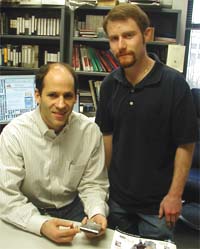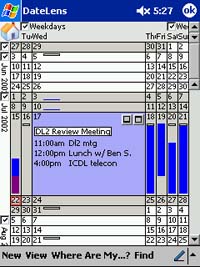|
Maryland Newsline |
|
Home Page |
|
Related Links: The DateLens site tells more about the program. You can download DateLens for free for your desktop computer.
The Human-Computer Interaction Lab studies the way people work with computers. |
UMD Director Creates New Kind of Calendar
By Daina Klimanis COLLEGE PARK, Md. – Around dawn one morning, Ben Bederson woke up, turned over, and looked at the window. He saw his Venetian blinds and imagined a new kind of menu, the information expanding and contracting. The idea ultimately became the basis of DateLens, a program designed to make managing a calendar of appointments easier. With DateLens, users zoom in and out to get the information they need, so they can skip across their calendar, appointment to appointment, even on a screen just inches wide. “The problem we’re trying to solve is how to let the user view more data than fits on the screen,” said Bederson, an assistant professor at the University of Maryland, College Park, and director of the campus’ Human-Computer Interaction Lab. Most programs hide the unread information off-screen, requiring users to click or scroll to reach it. Keeping track of hidden data is conceptually difficult, Bederson said, and someone who has to move a mouse along a thin scroll bar can get distracted from the data.
He and collaborator Aaron Clamage, a programmer at the lab, tried to work around those problems with DateLens, which keeps information in context and rarely offscreen. Now in its final version, DateLens fits three months of appointments onto a palm-sized PDA screen. Bederson is used to dealing with the display of information. His Human-Computer Interaction Lab researches the way people interact with their computers. On his own computer screen, icons are not arranged in the typical rows and columns, but in loops and curves he said let him easily find what he wants. His several years of work on DateLens impressed Microsoft so much that last month it offered a three-year, $1 million grant to the Human-Computer Interaction Lab, so it could work on other technologies.
"Professor Bederson and his team … exemplify a refreshing balance between unrestrained research exploration and elegant software engineering," said John Sangiovanni, technical evangelist for Microsoft Research. Now Bederson is marketing DateLens through his own startup company, Windsor Interfaces Inc. The program is for sale next to PhotoMesa, another program Bederson helped create, which uses overviews and zooming to help users find saved image files. Though users need to pay $15 to use DateLens on their PDAs, Bederson allows people to download the program for free onto desktop computers. Copyright © 2004 University of Maryland Philip Merrill College of Journalism
|



